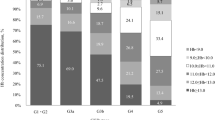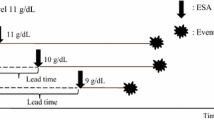Abstract
Background
Renal anemia complicated with chronic kidney disease is usually treated with erythropoiesis-stimulating agents (ESAs). However, few studies have compared the early response of hemoglobin (Hb) to different kinds of ESAs.
Methods
The effects of three types of ESAs—epoetin alfa or beta (EPO), darbepoetin alfa (DPO), and epoetin beta pegol (EPObp)—on renal anemia were followed in 416 pre-dialysis chronic kidney disease (CKD) patients. After the initial 12-week administration of ESAs, ΔHb/ESA dose/kg was calculated as an index of efficacy of each ESA. Furthermore, independent variables associated with ΔHb/ESA dose/kg (dependent variable) were determined using multiple linear regression analysis. The ten independent variables selected for analysis were: presence of diabetic nephropathy, estimated glomerular filtration rate (eGFR), Hb, albumin, iron (Fe), transferrin saturation (TSAT), ferritin, phosphate (P), intact parathyroid hormone (iPTH), and C-reactive protein.
Results
The efficacy of DPO and EPObp were similar and higher than EPO. TSAT was most strongly correlated with ΔHb/EPO dose/kg in all three types of ESAs. Other significant independent factors were Hb, albumin, P, iPTH, and diabetic nephropathy in the EPO group, eGFR in the DPO group, and Fe in the EPObp group. The adjusted coefficient of determination (R 2) ranged from 0.415 to 0.520 in the three ESA groups.
Conclusions
The study results suggest that TSAT is the best predictor of the initial 12-week responsiveness to ESA, irrespective of the type. Variables not investigated in this study also affect responsiveness to ESA in Japanese pre-dialysis CKD patients.

Similar content being viewed by others
References
Sarnak MJ, Tighiouart H, Manjunath G, MacLeod B, Griffith J, Salem D, et al. Anemia as a risk factor for cardiovascular disease in The Atherosclerosis Risk in Communities (ARIC) study. J Am Coll Cardiol. 2002;40:27–33.
Lee PC, Kini AS, Ahsan C, Fisher E, Sharma SK. Anemia is an independent predictor of mortality after percutaneous coronary intervention. J Am Coll Cardiol. 2004;44:541–6.
Locatelli F, Aljama P, Bárány P, Canaud B, Carrera F, Eckardt KU, et al. Revised European best practice guidelines for the management of anaemia in patients with chronic renal failure. Nephrol Dial Transplant. 2004;19(Suppl 2):ii1–47.
KDOQI, National Kidney Foundation. KDOQI clinical practice guidelines and clinical practice recommendations for anemia in chronic kidney disease. Am J Kidney Dis. 2006;47(Suppl 3):S11–145.
Curran MP, McCormack PL. Methoxy polyethylene glycol-epoetin beta: a review of its use in the management of anaemia associated with chronic kidney disease. Drugs. 2008;68:1139–56.
Tsubakihara Y, Nishi S, Akiba T, Hirakata H, Iseki K, Kubota M, et al. 2008 Japanese Society for Dialysis Therapy: guidelines for renal anemia in chronic kidney disease. Ther Apher Dial. 2010;14:240–75.
Solomon SD, Uno H, Lewis EF, Eckardt KU, Lin J, Burdmann EA, et al. Erythropoietic response and outcomes in kidney disease and type 2 diabetes. N Engl J Med. 2010;363:1146–55.
Panichi V, Rosati A, Bigazzi R, Paoletti S, Mantuano E, Beati S, et al. Anaemia and resistance to erythropoiesis-stimulating agents as prognostic factors in haemodialysis patients: results from the RISCAVID study. Nephrol Dial Transplant. 2011;26:2641–8.
Fukuma S, Yamaguchi T, Hashimoto S, Nakai S, Iseki K, Tsubakihara Y, et al. Erythropoiesis-stimulating agent responsiveness and mortality in hemodialysis patients: results from a cohort study from the dialysis registry in Japan. Am J Kidney Dis. 2012;59:108–16.
Minutolo R, Conte G, Cianciaruso B, Bellizzi V, Camocardi A, De Paola L, et al. Hyporesponsiveness to erythropoiesis-stimulating agents and renal survival in non-dialysis CKD patients. Nephrol Dial Transplant. 2012;27:2880–6.
Kuwahara M, Mandai S, Kasagi Y, Kusaka K, Tanaka T, Shikuma S, et al. Responsiveness to erythropoiesis-stimulating agents and renal survival in patients with chronic kidney disease. Clin Exp Nephrol. 2014. doi:10.1007/s10157-014-1023-9.
Tonelli M, Blake PG, Muirhead N. Predictors of erythropoietin responsiveness in chronic hemodialysis patients. ASAIO J. 2001;47:82–5.
Johnson DW, Pollock CA, Macdougall IC. Erythropoiesis-stimulating agent hyporesponsiveness. Nephrology (Carlton). 2007;12:321–30.
Kalantar-Zadeh K, Lee GH, Miller JE, Streja E, Jing J, Robertson JA, et al. Predictors of hyporesponsiveness to erythropoiesis-stimulating agents in hemodialysis patients. Am J Kidney Dis. 2009;53:823–34.
De Francisco AL, Stenvinkel P, Vaulont S. Inflammation and its impact on anaemia in chronic kidney disease: from haemoglobin variability to hyporesponsiveness. NDT. 2009;2(Suppl_1):i18–26.
de Cabrita CLA, Pinho A, Malho A, Morgado E, Faísca M, Carrasqueira H, et al. Risk factors for high erythropoiesis stimulating agent resistance index in pre-dialysis chronic kidney disease patients, stages 4 and 5. Int Urol Nephrol. 2011;43:835–40.
Matsuo S, Imai E, Horio M, Yasuda Y, Tomita K, Nitta K, et al. Revised equations for estimated GFR from serum creatinine in Japan. Am J Kidney Dis. 2009;53:982–92.
Kuwahara M, Hasumi S, Mandai S, Tanaka T, Shikuma S, Akita W, et al. Effects of three kinds of erythropoiesis-stimulating agents on renal anemia in Japanese non-dialysis chronic kidney disease patients. Clin Exp Nephrol. 2014;18:755–62.
Gum PA, Thamilarasan M, Watanabe J, Blackstone EH, Lauer MS. Aspirin use and all-cause mortality among patients being evaluated for known or suspected coronary artery disease: a propensity analysis. JAMA. 2001;286:1187–94.
Ahmed A, Husain A, Love TE, Gambassi G, Dell’Italia LJ, Francis GS, Gheorghiade M, et al. Heart failure, chronic diuretic use, and increase in mortality and hospitalization: an observational study using propensity score methods. Eur Heart J. 2006;27:1431–9.
Stuart EA, Rubin DB. Best practices in quasi-experimental designs: Matching methods for causal inference. In: Osborne J, editor. Best practices in quantitative social science. Thousand Oaks: Sage Publications; 2007. p. 155–76.
Nakai S, Hanafusa N, Masakane I, Taniguchi M, Hamano T, Shoji T, et al. An overview of regular dialysis treatment in Japan (as of 31 December 2012). Ther Apher Dial. 2014;18:535–602.
Kakimoto-Shino M, Toya Y, Kuji T, Fujikawa T, Umemura S. Changes in hepcidin and reticulocyte hemoglobin equivalent levels in response to continuous erythropoietin receptor activator administration in hemodialysis patients: a randomized study. Ther Apher Dial. 2014;18:421–6.
Washida N, Inoue S, Kasai T, Shinozuka K, Hosoya K, Morimoto K, et al. Impact of switching from darbepoetin alfa to epoetin beta pegol on iron utilization and blood pressure in peritoneal dialysis patients. Ther Apher Dial. 2015. doi:10.1111/1744-9987.2306.
Sasaki Y, Noguchi-Sasaki M, Matsuo-Tezuka Y, Matsumoto-Omori Y, Kurasawa M, Yorozu K, et al. Epoetin beta pegol (C.E.R.A.) promotes utilization of iron for erythropoiesis through intensive suppression of serum hepcidin levels in mice. Int J Hematol. 2014;99:561–9.
Author information
Authors and Affiliations
Corresponding author
Ethics declarations
Conflict of interest
The authors have declared that no conflict of interest exists.
About this article
Cite this article
Kuwahara, M., Arai, Y., Takehara, E. et al. Early response to erythropoiesis-stimulating agents in non-dialysis chronic kidney disease patients. Clin Exp Nephrol 20, 585–594 (2016). https://doi.org/10.1007/s10157-015-1188-x
Received:
Accepted:
Published:
Issue Date:
DOI: https://doi.org/10.1007/s10157-015-1188-x




